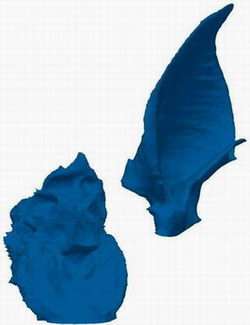December 1, 2006 feature
New Technology Could Go Batty

“There are many species of bats,” Rolf Müller tells PhysOrg.com, “and they live in different circumstances and environments, hunting different types of food. We can learn from this.” Müller and his Ph.D. student Qiao Zhuang hope that by looking at the adaptations of bats, they can create ways to enhance future technology.
Müller and Zhuang are both affiliated with Shandong University in Jinan, China. Their published paper in Physical Review Letters is titled “Noseleaf Furrows in a Horseshoe Bat Act as Resonance Cavities Shaping the Biosonar Beam.”
Müller believes that by cataloging the different ways that the ears and noseleaf furrows work in bats, it should be possible to develop sensory technology that is less expensive and more adaptable to its surroundings. Some of the applications Müller believes that his work could affect in the future include technical sonar, non-destructive testing of manufactured goods, non-invasive biomedical diagnosis, and wireless communication purposes. “The way bats distribute sound in space, and they way they distribute sensitivity is different from other systems.”
Understanding these differences could be key to developing less expensive communications technology. “Unlike our current technical systems,” explains Müller, “bats have much more freedom of choice in where to listen. It’s like having a flashlight that you can shine where you would like.” He carries the flashlight analogy further to explain: “The bats can also change the shape they are using, to make it an ellipse instead of a circle. It’s like being able to do more than just make a circle bigger or smaller by moving the flashlight. You change the shape the light makes.”
The current look at horseshoe bats offers some insight into resonance. There is a mechanism that appears to allow the bat to do different things with some frequencies, and do other things on different frequencies. “We have seen mechanisms in the bats that help generate this effect, and if we can figure out how to do it, we could do it on the cheap. Right now you need lots of different antennas and signals, and that starts to get expensive. But if we could mimic the bat, we would not need so many antennas and signals. Some communication functions would be less expensive.”
Müller explains that the bats seem to be able to increase their side-lobe sensitivity as well, which allows them to adjust their sound energy in different directions in deliberately varying strengths. He has even started making small models that resembled something partway between a bat’s ear and an antenna. “We still need more information,” he admits. “Information that can help us work toward something better.” And developing that information, he says, is the main thrust of his work.
While Müller sees the practical applications that his work could have in the technical world, he is truly interested in developing a way to methodize work with nature. “This field of bionic technology is more of an art form right now,” he says. “It’s based more on serendipity and what you just happen to discover.” Müller wants to focus more on engineering, on creating a set of objective methods that could be followed. “I want to be able to teach students that we can take rules and solve problems of technical application of what we find in nature.” He insists that his work with bats is a step further in the journey to extract actual rules for how evolution works, and how humans could mimic the workings of nature.
“We are just scratching the surface,” says Müller. “But we can learn from the way bats are built so that we can develop design rules and learn to do the same thing for technology.”
More on Dr. Müller’s collaborative research project can be found at www.cilia-bionics.org .
By Miranda Marquit, Copyright 2006 PhysOrg.com





















